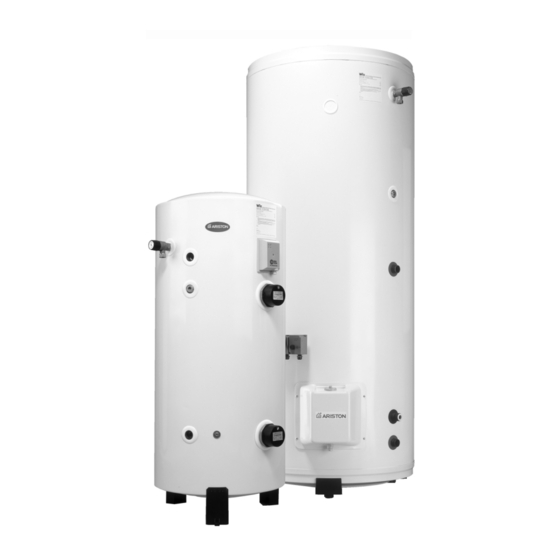Ariston STI 210 INDIRECT Instructions For Installation Manual - Page 10
Browse online or download pdf Instructions For Installation Manual for Boiler Ariston STI 210 INDIRECT. Ariston STI 210 INDIRECT 24 pages. Unvented hot water storage cylinders
Also for Ariston STI 210 INDIRECT: User Manual (16 pages), Installation Instructions Manual (20 pages)

2.9
C
ONNECTION TO
2.10
S
R
ECONDARY
2.11
D
P
ISCHARGE
IPEWORK
S
It is recommended that a 22mm pipe run should supply the outlets
ERVICES
throughout the building, especially to baths and showers. Short runs of
15mm pipe may be used to connect basins and sinks.
On floor-standing models a secondary return may be fitted (consult the label
ETURN
on the face of the unit for the correct location). A non-return valve (not
supplied) must be fitted to prevent back flow and a bronze pump will be
needed in conjunction with a pipe thermostat to circulate the hot water (both
not supplied).
N
OTE
volume of the secondary return exceeds the capacity of the expansion
vessel supplied.
1) The tundish must be vertical and fitted within 500mm of the temperature
2) Discharge pipes from the temperature & pressure relief and expansion
3) The pipe diameter must be at least one pipe size larger than the nominal
4) The discharge pipe must have a vertical section of pipe at least 300mm
5) The discharge pipe must be installed with a continuous fall.
6) The discharge must be visible at both the tundish and the final point of
: an extra expansion vessel may be required where the additional
& pressure relief valve and must be located with the cylinder. The tundish
must also be in a position visible to the occupants, and positioned away
from any electrical devices. The discharge pipe from the tundish should
terminate in a safe place where there is no risk to persons in the vicinity
of the discharge and to be of metal.
relief valve may be joined together.
outlet size of the safety device unless it's total equivalent hydraulic
resistance exceeds that of a straight pipe 9m long.
I.e. Discharge pipes between 9m and 18m equivalent resistance length
should be at least 2 sizes larger than the nominal outlet size of the safety
device. Between 18m and 27m at least 3 larger, and so on.
Bends must be taken into account in calculating the flow resistance.
See F
. 2.9 and T
2.
IG
ABLE
in length, below the tundish before any elbows or bends in the pipework.
discharge, but where this is not possible or practically difficult; there
should be clear visibility at one or other of these locations. Examples of
acceptance are:
i)
Ideally below a fixed grating and above the water seal in a trapped
gully.
ii) Downward discharges at a low level; i.e. up to 100mm above
external surfaces such as car parks, hard standings, grassed
areas etc. These are acceptable providing that where children
may play or otherwise come into contact with discharges, a wire
cage or similar guard is positioned to prevent contact, whilst
maintaining visibility.
iii) Discharges at high level; I.e. into a metal hopper and metal down
pipe with the end of the discharge pipe clearly visible (tundish
visible or not). Or onto a roof capable of withstanding high
temperature discharges of water 3m from any plastic guttering
systems that collect would such a discharge (tundish visible).
iv) Where a single pipe serves a number of discharges, such as in
blocks of flats, the number served should be limited to not more
than 6 systems so that any installation can be traced reasonably
easily. The single common discharge pipe should be at least one
pipe size large than the largest individual discharge pipe to be
connected. If unvented hot water storage systems are installed
where discharges from safety devices may not be apparent I.e. in
dwellings occupied by the blind, infirm or disabled people,
10
